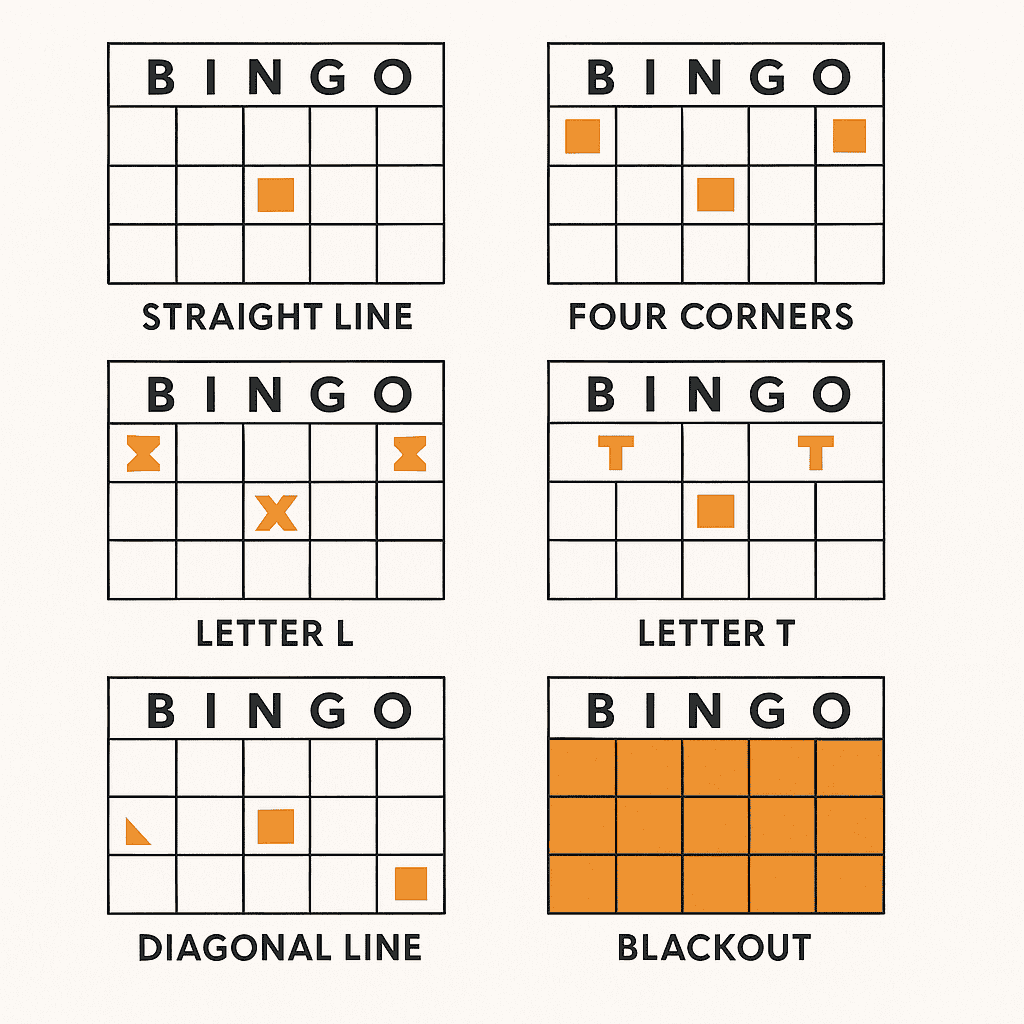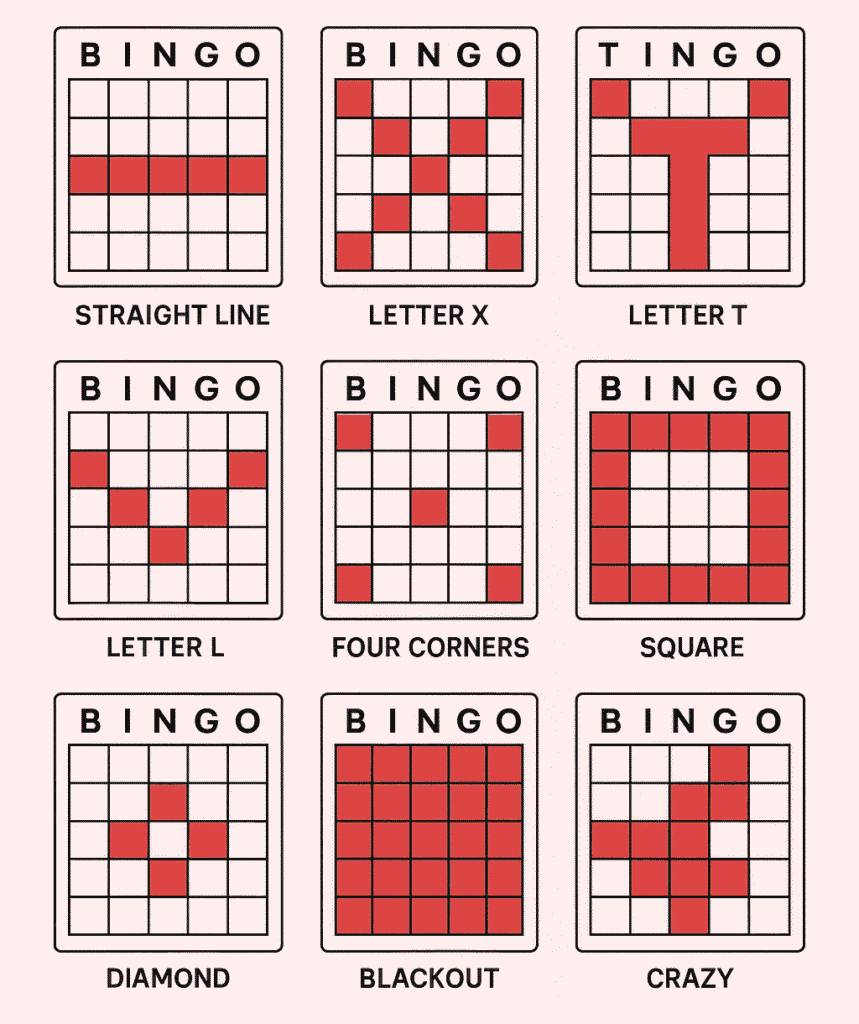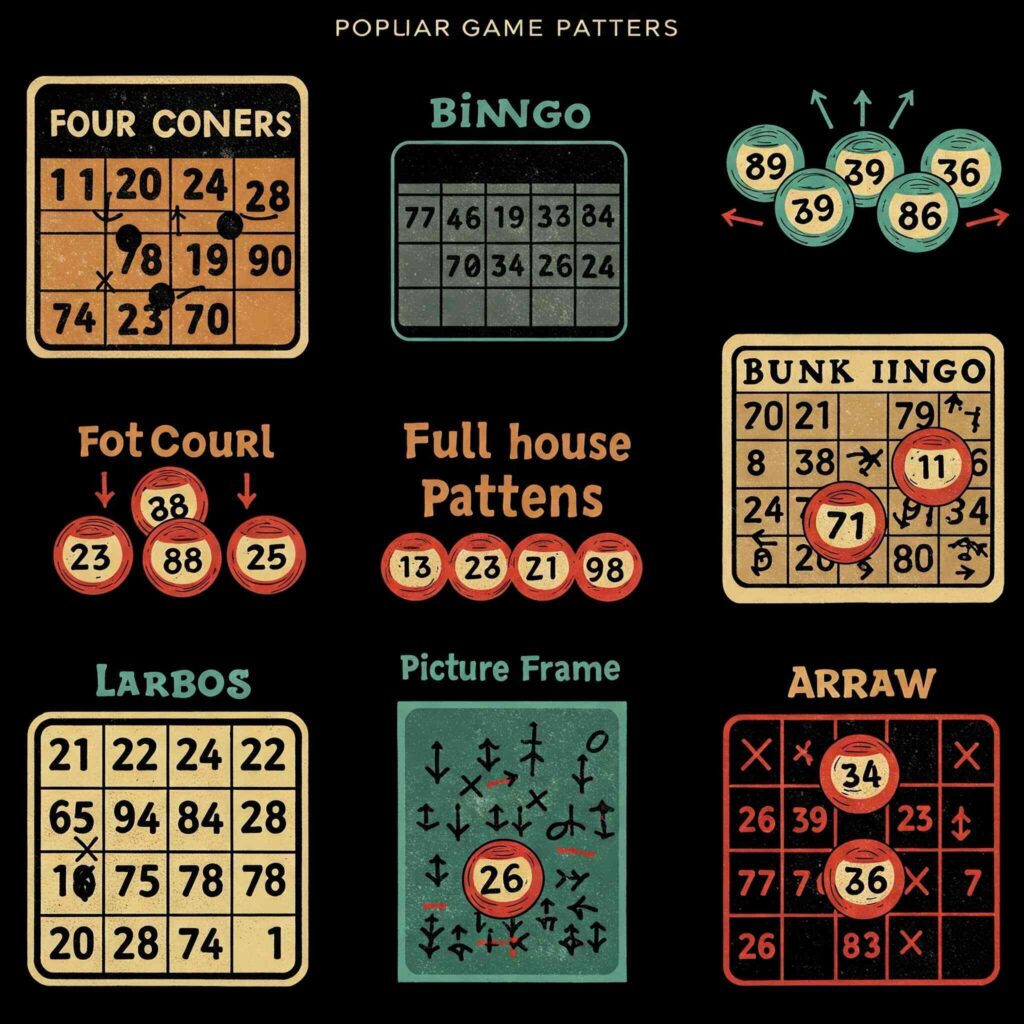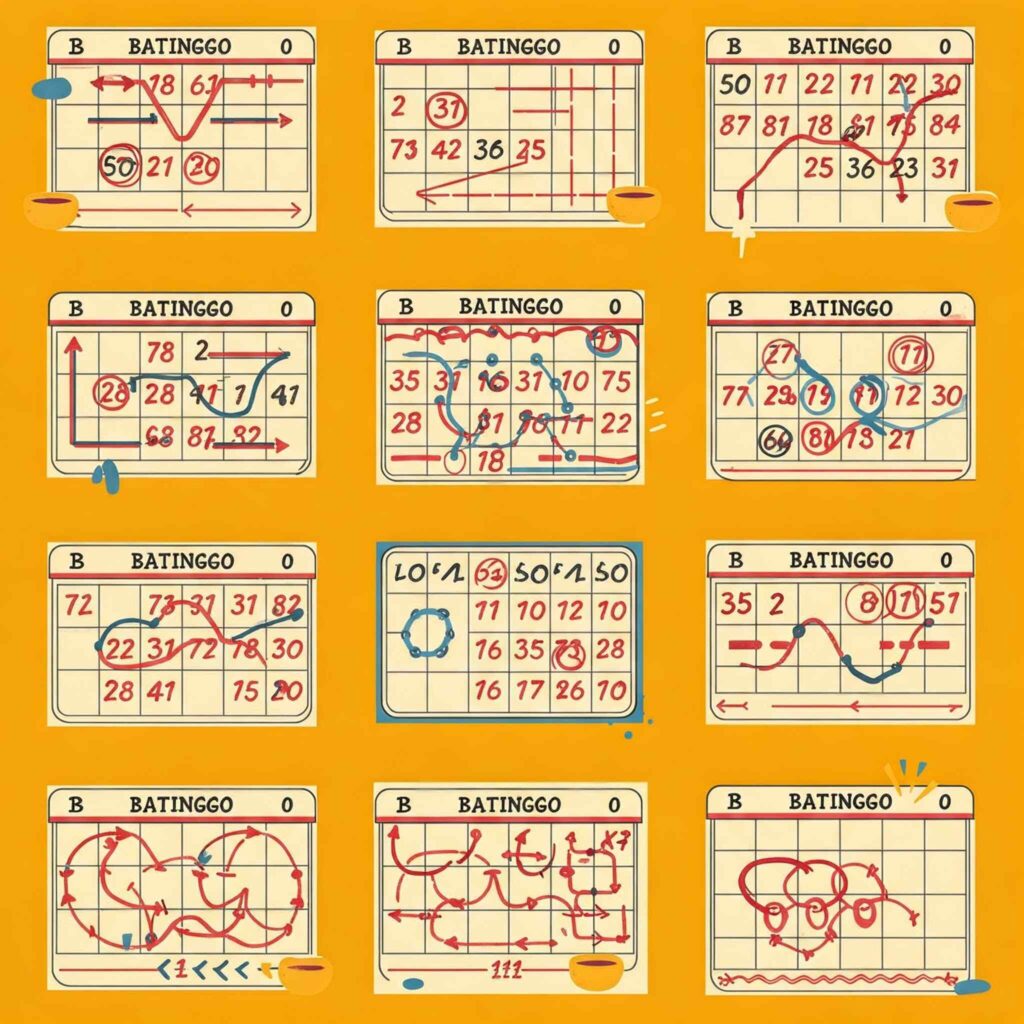Bingo game patterns are the heart of every bingo match, shaping the way players win and making each game unique and exciting. Whether you’re a beginner just learning the ropes or a seasoned player exploring new strategies, understanding the different bingo patterns can enhance your gameplay and boost your chances of winning.
What Are Bingo Game Patterns?
Put simply, bingo game patterns are the particular layouts of numbers on a bingo card that players need to complete to achieve a win. These patterns can range from simple straight lines to complex shapes, and each game comes with a predefined winning pattern.
These patterns are especially important because they change the pace, difficulty, and strategy of the game. Some patterns are quick to achieve, while others take longer and may offer bigger rewards.
Why Patterns Matter in Bingo
Understanding bingo patterns isn’t just for fun—it’s essential for competitive play. Here’s why:
- Defines Winning Criteria: You must match the required pattern to win.
- Adds Variety: Different patterns keep the game fresh and exciting.
- Affects Strategy: Some patterns encourage players to mark certain areas faster.
- Impacts Game Length: Simpler patterns mean shorter games; complex ones take longer.
Whether you’re playing online or at a bingo hall, always pay attention to the pattern announced at the beginning of each game.
Quick Summary Table: Some Bingo Game Patterns FAQs
| Question | Quick Answer |
|---|---|
| What are the different patterns of bingo? | Lines can be horizontal, vertical, or diagonal; there are four corners, a full house, and imaginative shapes like T, X, or diamonds. |
| How to win bingo patterns? | Stay focused, manage multiple cards wisely, understand the pattern before starting, and join games with fewer players. |
| What are the 7 ways to bingo? | Horizontal line, vertical line, two diagonals, four corners, full house, and special letter shapes. |
| What is the format of a bingo game? | Get cards → Learn the pattern → Caller draws numbers → Mark numbers → Shout “Bingo” → Verify and win. |
| What is the secret of bingo game pattern? | Use balanced cards, play at quieter times, and stay fully alert during the game. |
| What is the fastest pattern in bingo? | A Single Line pattern — horizontal, vertical, or diagonal with just five numbers needed. |
Most Common Bingo Game Patterns
Let’s explore some of the most frequently used patterns in bingo. These are often seen in both traditional and online formats.
1. Straight Line
- A line may run horizontally, vertically, or diagonally across the card.
- It’s the most basic and widely used pattern.
- Quick to complete, often found in beginner games.
2. Four Corners
- You win by marking only the four corners of the card.
- Looks easy, but can be more challenging than it seems.
3. Full House or Blackout
- To win with a full house, every number on the bingo card must be marked off.
- Usually offers the biggest prize.
- Takes the longest to complete.
4. Letter Patterns (T, X, Z, E, L, etc.)
- The marked numbers must form a specific letter.
- Adds a fun twist and a bit more challenge.
5. Diamond Pattern
- Numbers form a diamond shape on the card.
- Often used in themed games.
6. Border or Frame
- All outer edge numbers must be marked.
- Visually striking and fairly challenging.
7. Arrow Pattern
- Numbers form an arrow shape.
- Great for intermediate players looking for something new.
8. Kite Pattern
- Numbers make a kite shape, often used in special events.
- Rare but fun and visually interesting.
Unique and Themed Bingo Patterns
Many bingo sites, especially online, offer seasonal or themed patterns to keep the games fresh and exciting:
- Christmas Tree: Seen in holiday-themed games.
- Heart Shape: Common on Valentine’s Day.
- Birthday Cake: Used in birthday events or celebrations.
- Smiley Face: Adds fun to casual play sessions.
These patterns bring a sense of creativity and excitement, especially in community games and special bingo nights.
Bingo Patterns by Bingo Type
The type of bingo you’re playing can influence which patterns are possible:
75-Ball Bingo
- Most flexible in terms of patterns.
- Cards are 5×5 grids.
- Patterns can be simple or complex.
90-Ball Bingo
- Patterns are usually based on lines (one line, two lines, full house).
- Cards are 9×3.
- Used primarily in UK and Australia.
80-Ball Bingo
- Played on a 4×4 grid.
- Offers unique square and row-based patterns.
30-Ball Bingo
- Fast-paced, 3×3 card.
- Limited to simpler patterns like full house.
Each version has its unique gameplay experience, so it’s good to familiarize yourself with how patterns work in each type.
The Basics: How to Play Bingo
Bingo Cards
Every player receives at least one bingo card (also called a ticket or sheet). Traditional bingo cards feature:
- A 5×5 grid (in American bingo)
- Numbers randomly arranged in columns
- A “FREE” space in the center (in most American versions)
In the UK version (90-ball bingo), cards typically have three rows and nine columns, with five numbers per row.
Number Calling
A caller (or an automated system in online versions) randomly selects numbers and announces them to all players. In traditional bingo halls, these numbers are often drawn using:
- A mechanical ball machine
- A computerized random number generator
- Numbered balls in a cage or drum
Each announced number is typically accompanied by a letter (B-I-N-G-O in American bingo), corresponding to the column where you’d find the number on your card.
How to Spot and Complete Patterns Efficiently
Mastering bingo game patterns is all about focus and practice. Here are some helpful tips:
- Check the Pattern Before the Game Starts: Always know what you’re aiming for.
- Use Fewer Cards If You’re New: It’s easier to track patterns when you’re not overwhelmed.
- Highlight the Pattern Visually: In digital games, this is done automatically. For paper cards, you can circle or note the shape.
- Play on Trusted Platforms: Online games usually help track progress visually, making pattern recognition easier.
Practical Playing Tips
Play Multiple Cards: Playing more cards increases your chances of winning, but only play as many as you can effectively manage without missing numbers.
Avoid Peak Hours: If playing in-person, consider attending games during off-peak hours when there’s less competition.
Stay Alert: Maintain focus throughout the game to avoid missing called numbers.
Use Electronic Options: When available, electronic daubers or auto-daub features can help you manage multiple cards efficiently.
Popular Bingo Resources and Platforms
Mobile Bingo Apps
For gaming on the go:
- Bingo Blitz: Features colorful themes and worldwide tournaments.
- Bingo Bash: Offers multiple rooms and frequent special events.
- Bingo Pop: Known for vibrant graphics and bonus features.
DIY Bingo Resources
For hosting your own games:
- Bingo Card Generator: Websites like myfreebingocards.com allow you to create custom cards.
- Printable Bingo Cards: Many sites offer free printable cards for home games.
- Bingo Calling Apps: Simulate the random number calling experience.
Variations and Alternative Bingo Games
Themed Bingo
- Musical Bingo: Instead of numbers, songs are played, and players mark them off their cards.
- Picture Bingo: Uses images instead of numbers, popular for children and educational settings.
- Holiday Bingo: Themed around celebrations like Christmas or Halloween.
Online Bingo Patterns vs Traditional Patterns
In traditional bingo, the patterns are usually announced by the caller and must be tracked manually. Online, things are more automated:
- Auto-Daubing: Marks your numbers for you.
- Pattern Indicators: Show you how close you are to completing a pattern.
- Alerts and Notifications: Inform you when you’re one number away.
These digital tools are great for beginners but can take some of the manual fun away for seasoned players.
Challenges and Misconceptions
Let’s clear up some common issues and myths around bingo patterns:
- “All patterns are equally easy” – Not true. A straight line is far easier than a complex letter pattern.
- “Patterns don’t affect the game” – They directly impact duration and difficulty.
- “You only win on Full House” – Many games allow wins on different patterns.
Understanding these details makes the game more strategic and enjoyable.
Tips and Tricks for Success Bingo Patterns
While bingo is largely based on luck, a few smart strategies and tips can enhance your enjoyment and potentially increase your chances of winning (though no guarantees in this game of chance!):
- Play Multiple Cards (Wisely): Playing more cards gives you more numbers in play and thus more opportunities to hit a winning pattern. However, be realistic about how many cards you can effectively manage. Trying to track too many at once can lead to missed numbers. Online bingo 101 often makes managing multiple cards easier with auto-dab features.
- Listen Carefully: This might seem obvious, but in a fast-paced game, it’s crucial to pay close attention to the numbers being called. Mishearing a number can cost you a potential win.
- Know the Odds (Sort Of): While you can’t predict the numbers, understanding the number ranges for each column (B 1-15, I 16-30, etc.) can sometimes help you quickly scan your card.
- Choose Your Games Strategically: Some bingo games have fewer players, which can statistically increase your odds of winning (as there’s less competition). Look for games with smaller jackpots, as they often attract fewer participants.
- Utilize Auto-Dab Features Online: If you’re playing online, take advantage of the auto-dab or auto-mark feature. This ensures you never miss a number and allows you to manage more cards simultaneously without the risk of human error.
- Consider the Pattern: If the winning pattern is something other than a straight line, try to focus on marking numbers that contribute to that specific shape. For example, if it’s a “Full House,” every number matters.
- Stay Alert: Bingo can be surprisingly engaging! Avoid distractions to ensure you don’t miss crucial numbers.
- Socialize and Have Fun! Bingo is often a social activity. Enjoy the camaraderie, chat with other players (especially in online bingo rooms), and remember that the primary goal is to have a good time.
Tips for Winning Pattern-Based Bingo Games
Want to get better? Try these tips:
- Choose Patterns You Understand: Don’t jump into a themed pattern without knowing what it looks like.
- Practice on Free Games: Many online sites offer free rounds to get familiar.
- Stay Alert and Engaged: Missed numbers mean missed chances.
- Join Communities: Forums and chat rooms often discuss strategy and share pattern tips.
Final Thoughts: Make Bingo Patterns Work for You
Bingo game patterns are more than just winning shapes—they’re the backbone of what makes bingo fun, challenging, and endlessly replayable. Once you understand the patterns and how to work with them, your bingo experience becomes more rewarding.
Whether you play casually with friends or dive into competitive online bingo rooms, knowing your patterns gives you a valuable edge. So next time you grab your dauber or log into your favorite bingo app, keep an eye on that pattern. It could be your path to shouting “Bingo!”
Frequently Asked Questions (FAQs)
The straight line is the easiest and most common pattern, ideal for beginners.
No, the winning pattern is usually announced at the beginning and remains fixed throughout the game.
Yes. If two players complete the pattern on the same number, they usually split the prize.
They can be. Online games often offer more creative and themed patterns due to their flexibility.
Practice regularly, start with simple patterns, and use online games that provide visual aids.
Often, yes. More difficult patterns typically come with higher prizes.
Yes, but only if you can manage them. More cards mean better odds, but also more to track.
Absolutely! In casual or community games, players often create their own fun and unique patterns.
Most do, but some variations like 90-ball bingo focus more on line completion than shapes.
That depends on your style, but many players enjoy themed or letter patterns for the added challenge and creativity.
Bonus FAQs About Bingo Game Patterns
What are the different patterns of bingo?
Bingo patterns are the specific ways you must mark your numbers on a card to win. Some common patterns include:
- Horizontal Line: Five numbers marked in a straight row across.
- Vertical Line: Five numbers marked down a single column.
- Diagonal Line: Five numbers from corner to corner.
- Four Corners: Mark all four corner numbers of the card.
- Full House (Blackout): Mark each number on the card.
- T-shape, X-shape, or L-shape: Designated letter formations.
- Diamond, Arrow, or Heart: Fun, creative shapes depending on the game.
Each game announces the required pattern before starting, so you always know what you’re aiming for!
How to win bingo patterns?
Winning bingo patterns comes down to matching the called numbers to your card and completing the announced pattern before anyone else. Here are simple tips to boost your chances:
- Focus and pay close attention to every number called.
- Play multiple cards (but only as many as you can manage comfortably).
- Pick games with fewer players when possible—less competition means better odds.
- Stay relaxed and alert—a clear mind spots matches faster.
- Understand the pattern before the game starts so you don’t waste time marking unnecessary numbers.
While there’s no guaranteed method (since it’s luck-based), being prepared and focused can give you an edge.
What are the 7 ways to bingo?
There are many ways to win at bingo, but when people refer to the “7 ways to bingo,” they typically mean achieving bingo through these seven simple patterns:
- Horizontal Line (any of the five rows)
- Vertical Line (any of the five columns)
- Diagonal Line (from top left to bottom right)
- Diagonal Line (from top right to bottom left)
- Four Corners (top left, top right, bottom left, bottom right)
- Full House (Blackout) (every number marked)
- Any Specific Shape (like a T, X, or other announced design)
These classic paths to bingo are often taught to beginners because they cover the most common and easiest ways to win.
What is the format of a bingo game?
The basic format of a bingo game usually follows these steps:
- Card Distribution: Players receive one or more bingo cards.
- Pattern Announcement: The winning pattern is explained before starting.
- Number Calling: Numbers are drawn and called out one at a time.
- Marking Numbers: Players indicate or mark their cards with matching numbers.
- Winning Call: The first player to complete the pattern calls out “Bingo!”
- Verification: The winning card is checked against the called numbers.
- Prize Awarded: If verified, the prize is awarded; if not, the game continues.
Modern variations might add jackpots, multiple patterns, or speed rounds, but this basic structure is common across almost all bingo games.
What is the secret of bingo game pattern?
The “secret” of winning with bingo game patterns lies in balance and attention:
- Balanced Cards: Choose cards with a good mix of high and low numbers, even and odd numbers, and spread across all columns. This is based on Granville’s Strategy, which suggests that well-balanced cards have a slightly better chance as the game progresses.
- Full Focus: Stay sharp and attentive to mark your numbers quickly. Missing a number can cost you the game.
- Game Timing: Play during times when fewer players are present, so there’s less competition for the winning pattern.
While you can’t control the numbers called, managing your cards and staying mentally sharp is the best kept “secret” to success.
What is the fastest pattern in bingo?
The fastest pattern in bingo is usually the Single Line—whether it’s horizontal, vertical, or diagonal.
Because you only need to mark five numbers in a row, a single line can be completed in just a few calls if luck is on your side. Compared to patterns like a Full House, which takes much longer, a Single Line bingo game is quick, exciting, and often used in speed bingo or warm-up games.





